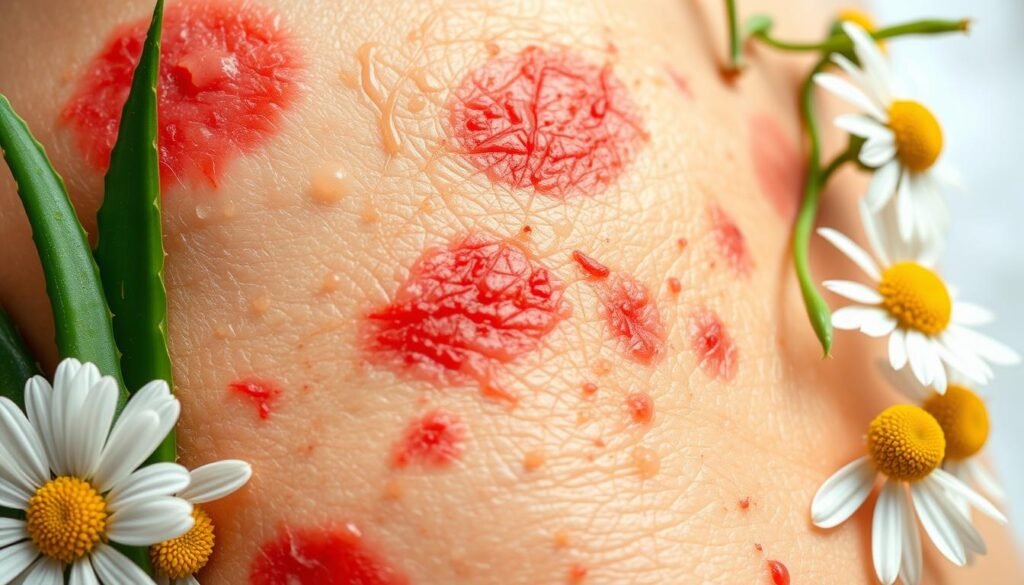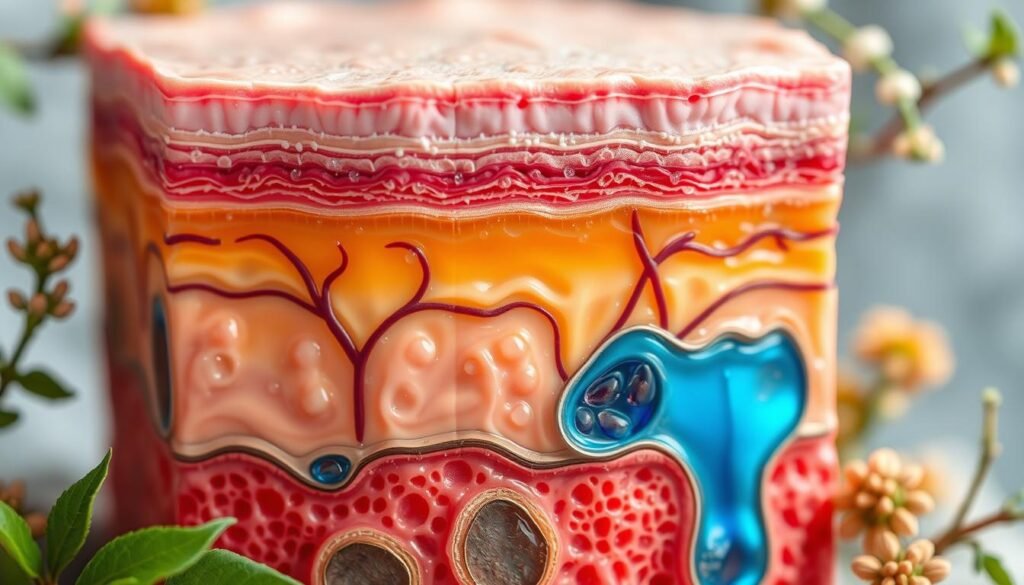Did you know over 31 million Americans have eczema? Among them, atopic dermatitis affects many. It hits over 9.6 million kids and about 16.5 million adults in the U.S. This skin issue can cause dry, itchy patches. It can really lower one’s quality of life.
It’s a complicated condition with both genetic and environmental reasons. Knowing about dermatitis atopica is key to handling it well. This article will explore its causes and natural ways to treat it. We aim to help you feel better and improve your skin health.
Key Takeaways
- Dermatitis atopica is a chronic condition that causes dry, inflamed skin.
- Over 31 million Americans experience some form of eczema.
- Effective management often requires understanding both genetic and environmental triggers.
- Natural treatments can help alleviate symptoms of dermatitis atopica.
- Consistent skincare routines play a crucial role in preventing flare-ups.
- This condition is prevalent in children but can manifest at any age.
Understanding Dermatitis Atopica
Dermatitis atopica, known as atopic dermatitis, is a chronic skin condition. It affects both children and adults in developed countries. In these places, about 10% to 30% of kids and 2% to 10% of adults have it. The symptoms include dry, itchy patches that come and go. Due to a two-to-three-fold increase in cases recently, it’s vital to understand what makes it different from other eczemas. This knowledge is key for effective control.
Signs of atopic dermatitis can show as early as two months of age. By the time they are one, 60% of affected kids show symptoms. While some outgrow it by their teens, others continue to deal with it. A big cause is genetics, especially mutations in a gene called filaggrin. In fact, up to 30% of patients have these genetic markers.
Food allergies can also make atopic dermatitis worse. Common triggers include eggs, milk, peanuts, soy, and wheat. Knowing what sets off an individual’s symptoms is crucial. Additionally, atopic dermatitis often occurs alongside other conditions, like asthma. This makes the situation more complex and calls for detailed care plans.
To manage it, focus on skin care that keeps moisture in and protects the skin barrier. An eczema-friendly skin care routine can greatly improve skin health and reduce flare-ups. Research suggests that daily moisturizing may lower the chance of developing atopic dermatitis, especially for those at higher risk. Though there’s no cure yet, effective treatments can ease discomfort and clear up the skin. This helps improve life for those dealing with it.
| Age of Onset | Percentage of Cases | Resolution by Age 12 |
|---|---|---|
| Birth to 2 years | ~60% | 60% |
| Late Onset (Post-puberty) | Variable | N/A |
| Senile Onset (Over 60) | Rare | N/A |
Causes of Dermatitis Atopica
The reasons behind dermatitis atopica include genetics and the environment. Both aspects are critical in understanding this skin condition. Knowing them helps manage it better.
Genetic Factors
Genetics play a big part in dermatitis atopica. If your family has a history of atopic dermatitis, asthma, or allergies, you’re more likely to get it. This often links back to changes in the FLG gene. This gene helps keep our skin strong. But, if it changes, our skin can’t hold moisture well. This makes it easier for irritants to cause eczema.
Environmental Triggers
The environment also affects dermatitis atopica. Things like dust mites, pollen, and pet hair can cause eczema to flare up. So can irritants in soaps and detergents. Knowing what triggers your eczema can help you avoid those things. This way, you can keep your eczema under better control.
| Factors | Impact on Dermatitis Atopica |
|---|---|
| Genetic Predisposition | Increased risk of developing the condition; common in families with allergies or asthma. |
| Environmental Factors | Triggers such as dust mites, pollen, and irritants from products can exacerbate symptoms. |
| Eczema Triggers | Identification of personal triggers allows for better management of flare-ups. |
Common Symptoms of Dermatitis Atopica
Dermatitis atopica, often called eczema, has many symptoms. It’s important to know these to manage the condition well.
Itchy Skin and Pruritus
Itchy skin, or pruritus, is a main symptom. It can interrupt sleep and make it hard to focus. Scratching leads to more irritation, making the skin inflamed and damaged.
Dry, Cracked Skin
Many people with eczema have dry skin. It looks parched or cracked, raising infection risk. Using moisturizers helps, but it’s essential to manage well.
Rashes and Inflammation
The condition often shows as skin rashes. You might see red or brownish-gray spots with raised bumps. These bumps can ooze and lead to more issues. The rashes appear in various patterns, showing the condition’s complexity.

For deep insights and tips on managing this condition, visit this resource.
Role of the Skin Barrier in Dermatitis Atopica
The skin barrier is crucial for keeping moisture in and harmful elements out. However, in those with dermatitis atopica, this barrier does not work well. This leads to more symptoms and discomfort. Knowing how the skin barrier works helps us find better ways to manage this condition.
Importance of Moisture Retention
A good skin barrier keeps the skin moist and healthy. But in dermatitis atopica, it fails to do so. This results in dry, cracked skin. Using special moisturizers can help. These moisturizers make the skin better at holding onto water.
They often contain dexpanthenol, which makes the skin stronger. This is key for people with this skin condition.
Impact of Skin Microbiome
The skin microbiome is key to healthy skin. Yet, a bad microbiome can make things worse for those with dermatitis atopica. It leads to more inflammation and irritation. Over 90% of those with the condition have skin covered in Staphylococcus aureus. This makes their symptoms more severe.
Using specific treatments to balance the skin microbiome can help. Studies show these treatments improve skin conditions. For more details on how the skin and microbiome work together, check this source.

| Factor | Impact on Dermatitis Atopica |
|---|---|
| Skin Barrier Dysfunction | Inadequate moisture retention leads to dry skin. |
| Moisturizers | Can improve barrier function and reduce relapse rates. |
| Skin Microbiome | Disruption linked to increased irritation and inflammation. |
| Staphylococcus aureus Colonization | Common in patients, exacerbating symptoms. |
| Dexpanthenol | Stimulates lipid synthesis, aiding barrier repair. |
Natural Treatments for Dermatitis Atopica
Looking into natural treatments can offer relief for dermatitis atopica sufferers. There are various natural methods that help soothe the skin and improve its health. Some of these include aloe vera, coconut oil, and colloidal oatmeal in care routines. Each treatment has its unique way of easing eczema symptoms.
Aloe Vera Gel
Aloe vera gel is known for its soothing properties. It fights inflammation and germs, making it great for treating the skin. Using it regularly can ease pain and help the skin heal. Many with eczema trust aloe vera to manage their symptoms.
Coconut Oil
Coconut oil is a wonderful natural moisturizer. It helps keep moisture in and fights off inflammation for better skin health. It’s celebrated for creating a protective skin layer. This makes it a valued part of natural treatments for eczema. Its nourishing effects are why it’s a key item in skincare routines.
Colloidal Oatmeal
Colloidal oatmeal is a top choice for managing dry, itchy skin. It works well in baths or when applied directly to the skin. A study from 2015 found it has antioxidant and anti-inflammatory qualities. This confirms its usefulness in natural treatments.

| Treatment | Benefits |
|---|---|
| Aloe Vera Gel | Anti-inflammatory, antimicrobial, soothes irritated skin |
| Coconut Oil | Locks in moisture, enhances skin barrier, reduces inflammation |
| Colloidal Oatmeal | Soothes dry skin, antioxidant properties, relieves itchiness |
Visit this relevant resource for more info on controlling symptoms and natural treatment options for dermatitis atopica.
Topical Treatments for Eczema and Dermatitis Atopica
Managing eczema well means using different topical treatments. These help ease symptoms and fix the skin. Hydrocortisone cream is popular for reducing inflammation and itch. It’s a mild corticosteroid. Whether over-the-counter or prescribed, hydrocortisone can help. But, you must use it right to avoid skin thinning issues.
Starting with moisturizers and self-care is key for atopic dermatitis. If problems stay, doctors might suggest medicated creams. Options include various corticosteroids or calcineurin inhibitors like tacrolimus ointment or pimecrolimus cream. These treatments work well but need careful use. There’s a concern over long-term effects, as warned by the FDA.
For tough cases, things like injectable biologics become options. Dupilumab and tralokinumab are for when usual treatments don’t work well. There are also methods like wet dressings with corticosteroids and light treatments. These use both sunlight and UV light.
Home care is hugely important for controlling eczema. Moisturizing regularly, using anti-itch creams, and not scratching can make a big difference. For repeat severe cases, bleach baths might help. They reduce skin bacteria and lower infection risks.
The table below compares various topical treatments for atopic dermatitis, outlining their common uses and noteworthy considerations:
| Topical Treatment | Common Uses | Considerations |
|---|---|---|
| Hydrocortisone Cream | Reduces inflammation and itching | Follow dosage instructions to prevent skin thinning |
| Corticosteroids | Treats various eczema symptoms | Report potential side effects like stretch marks or rosacea-like rashes |
| Calcineurin Inhibitors | Long-term management of eczema | Monitor for serious conditions as warned by the FDA |
| Biologics (e.g., Dupilumab) | Moderate to severe atopic dermatitis | Use under specialist supervision |
| Topical JAK Inhibitor (Opzelura) | Short-term treatment for mild to moderate eczema | Available for those 12 years and older |
Talking to healthcare providers is crucial for a good treatment plan. It combines topical treatments. Following doctors’ orders can lead to improved symptom management.
Dietary Changes to Manage Dermatitis Atopica
Changing what you eat can help control dermatitis atopica, especially if you have food allergies. Figuring out which foods worsen your symptoms is key to managing them better. Some people may see improvements by removing these allergens from what they eat.
Foods to Avoid
Certain foods might cause your eczema to get worse. These often include:
- Dairy products
- Eggs
- Nuts
- Wheat
- Fish
A study in 2022 found that about 30% of kids with eczema also react to foods. Cutting out these foods can make your skin better and lessen eczema. People who stopped eating gluten and processed foods had fewer eczema problems.
Anti-inflammatory Foods to Incorporate
You can eat anti-inflammatory foods to fight inflammation and boost skin health. Foods rich in omega-3s, like:
- Fatty fish like salmon and herring
- Chia seeds
- Walnuts
These items help lessen eczema’s effects. Foods like apples, berries, and green tea, which have quercetin, also reduce inflammation. Studies show changing your diet can help your immune system and manage dermatitis atopica better. It’s best to talk to doctors about which foods are right for you. They can guide you in making choices that could help your skin. Learn more about how what you eat affects your skin by checking out the link between diet and skin health.
Stress Management and Its Impact on Dermatitis Atopica
Stress plays a big role in the severity of eczema, or dermatitis atopica. Research shows that in the USA and Europe, about 20% of kids and 7% to 10% of adults suffer from this skin issue. Also, chronic stress is a bigger trigger for this condition than short-term stress. So, controlling stress is key to keeping your skin and yourself healthy.
Stress as a Trigger for Flare-ups
Those with atopic dermatitis say stress makes their symptoms worse. It leads to a stronger itch than what weather-related stress causes. Stress harms the skin’s defense and affects our immune system. This makes us more allergic. Hence, stress-reducing activities like mindfulness, yoga, and good sleep are important. They help lessen eczema issues and boost mental health.
Using stress management methods improves life quality for people with eczema. It also helps their skin get better. Programs that help reduce stress show benefits in how people with eczema feel and how their skin looks. Including mental health care with skin treatments offers a fuller approach to handle this chronic issue.